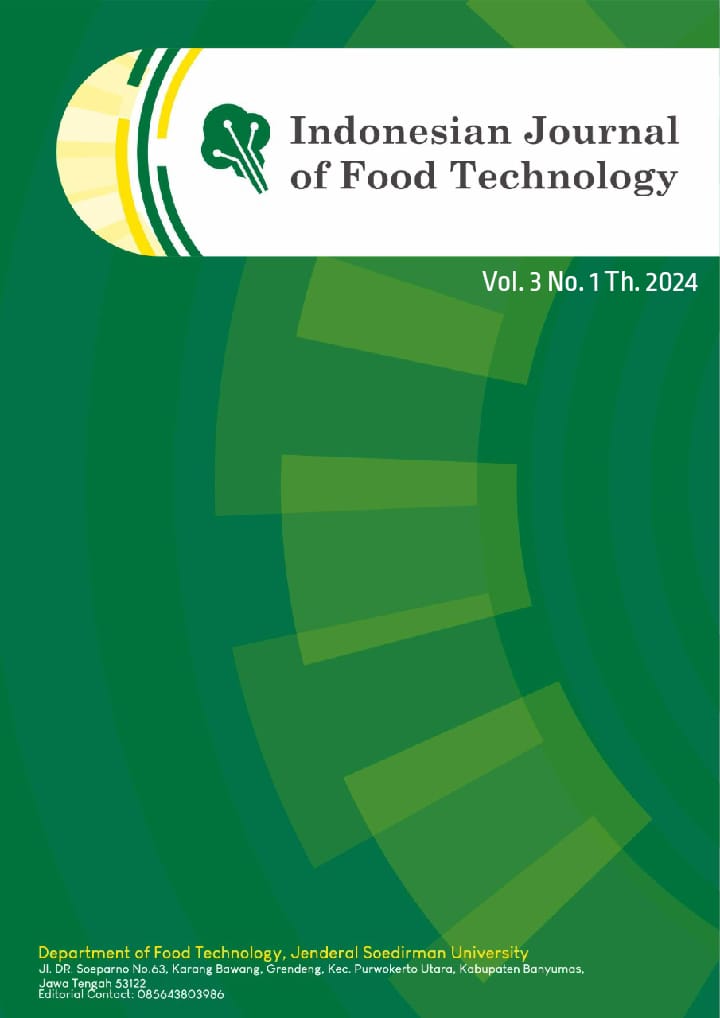The Effect of Different Bases of Vegetable and Carrageenan Concentrations on The Quality of The Mix Vegetable Leather of Lettuce and Mustars Greens
Abstract
The benefits of each vegetable are different, one vegetable cannot be substituted for another. Vegetable processing in Indonesia is still very limited to sautéed, boiled, steamed or eaten directly, meaning that people's interest in vegetable consumption is still relatively low. However, increasing public awareness of the use of vegetables encourages variations in vegetable processing. One of the processing that can be applied to vegetables is manufacturing mix vegetable leather. Vegetable leather is a processed product derived from crushed and dried vegetables. The diverse benefits of each vegetable encourage its creationmix vegetable leather orvegetable leather which uses more than 1 vegetable as the basic ingredient. Mustard greens and lettuce are vegetables with high production in Indonesia. Apart from that, the crude fiber from mustard greens is 51.07%, while lettuce contains 50.7% crude fiber. The purpose of this study is to obtain the effect of vegetable basis and carrageenan concentration variance on mix vegetable leather of lettuce and mustard greens. The increase of people awareness of vegetable utilization drives to variate the vegetable processing. Each vegetable has its own unique benefits thus they could not be easily subtituted and mixed. This study used RAL with two factors, those are variety of vegetable basis between lettuce and mustard greens (30,50,100) and carrageenan consentration (1% and 1,5%). The chemical respond in this study covers moisture content, ash content, and crude fiber, while the organoleptic respond covers color, aroma, flavor, and texture. The best treatment is found on A1B1, that has 30 g for vegetable basis and 1% of carrageenan consentration with 13,31 % moisture content, 12,29% ash content, 8,24% crude fiber, 3,7 score in color and 2,05 color quality; aroma 3.23 and aroma quality 2.80; taste 3.40 and taste quality 3.06; and texture 3.46 and texture quality 3.73.
References
Estiari.2016. Pengaruh perbandingan campuran labu siam (secheum edule) dan brokoli (brassica oleracea var italica) terhadap karakteristik fisik, kimia dan organoleptik mix fruit and vegetable leather. Jurnal Teknosains Pangan Vol.5 (4)
Fauziah, E., Widowati, E. dan Windi. 2015. Kajian Karakteristik Sensoris dan Fisikokimia Fruit Leather Pisang Tanduk (Musa corniculata) dengan Penambahan Berbagai Konsentrasi Karagenan. Jurnal Aplikasi Teknologi Pangan 4 (1):11-17
Food and Agriculture Organization (FAO). 2008. Nori. http://www.fao.org. Diakses: Mei 2019
Iqbal, K.R. 2017.Pengaruh konsentrasi κ-karagenan terhadap penilaian organoleptikproduk vegetable leather dari daun kelor (moringa oleifera l.). Jurnal Sains dan Teknologi Pangan, Vol. 2 (3): 641-647.
Kementerian Kesehatan RI. Tabel komposisi pangan Indonesia. www.panganku.org/id-ID/view
Kementrian Pertanian Republik Indonesia. 2017. Statistik Pertanian 2017, Jakarta: Kementrian Pertanian
Lalopua, V. 2017.pemanfaatan dan karakteristik nori tiruan menggunakan bahan baku alga Hypnea saidana dan Ulva conglubata dari perairan maluku. E-journal Kemenperin, Majalah BIAM 13 (02) 33-40
Muchtadi, D. 2001. Sayuran Sebagai Sumber Serat Pangan Untuk Mencegah Timbulnya Penyakit Degenaratif. Jurnal Teknologi dan Industri Pangan, Vol. XII (1)
Nanggiang, Dolfina.2016. Pengaruh perbandingan bubur rumput laut (Euchema cottoni) dengan bubur sawi (Brassica juncea) dan konsentrasi ekstrak daun suji TERHADAP karakteristik mix vegetable leather panggang. Jurnal Penelitian Tugas Akhir, Jurusan Teknologi Pangan, Fakultas Teknik, Universitas Pasundan, Bandung
Nurlaely, E.2002. Pemanfaatan buah jambu mete untuk pembuatan leather. [Skripsi].Fakultas Pertanian Universitas Brawijaya. Malang
Nuraeni, L., Garnida, Y. dan Sofyan, I. 2017. Pengaruh suhu dan lama pengeringan terhadap karakteristik tepung terubuk. Jurnal Penelitian, Fakultas Teknik, Teknik Pangan, Universitas Pasundan
Ogawa. (1990). Texture of Nori Porphyra spp. Journal Nippon Suisan Gakkaishi, 57(2),301-306
Safitri, E., Sudarno, Kusdawati, R. 2017. Pengaruh Penambahan Karagenan Terhadap Kandungan Serat Kasar dan Peningkatan Nilai Gel Strength Pada Produk Kamaboko dari Komposit Ikan Belanak (Mugil cephalus) dan Ikan Mujair (Oreochromis mossambicus). Journal of Marine and Coastal Science, 6 (2)
Santoso, J., Yoshie, Yumiko dan Suzuki, T. 2004. Komposisi Mineral, Asam Lemak dan Serat pada Beberapa Jenis Rumput Laut Indonesia. Jurnal Ilmu-Ilmu Perairan Dan Perikanan Indonesia. ISSN 0854-3194, 11 (1):45 – 51
Sidi, N., Widowati, E. dan Asri. 2014. Pengaruh Penambahan Karagenan pada Karakteristik Fisikokimia dan Sensoris Fruit Leather Nanas (Ananas Comosus L. Merr.) dan Wortel (Daucus Carota). Jurnal Aplikasi Teknologi Pangan 3 (4): 122-128
Stevani, N., Mustofa, A. dan Yustina. 2019. Pengaruh lama pengeringan dan penambahan karagenan terhadap karakteristik nori daun kangkung (Ipomoea reptans Poir). Jurnal JITIPARI Vol 3:85-96
Sudarmaji, S., Bambang, H dan Suhardi. 1997. Analisa Bahan Makanan dan Pertanian. Lyberty. Yogyakarta
Teddy, M. 2009. Pembuatan Nori Secara Tradisional dari Jenis Rumput Laut Gracillaria sp. Skripsi. Fakultas Perikanan dan Ilmu Kelautan. Institut Pertanian Bogor
Utama, I. dan Antara, N. (2013). Pasca Panen Tanaman Tropika: Buah dan Sayur. Modul Kuliah pada Universitas Udayana, Bali
Winarno, F. G. 1996. Teknologi Pengolahan Rumput Laut. Pustaka Sinar Harapan. Jakarta.
--------. 1997. Kimia Pangan dan Gizi. Jakarta: PT. Gramedia Pustaka Utama
Widyastuti, L. dan Adriyan, P. 2015. Intervensi hidden vegetable terhadap penerimaan sayuran pada anak prasekolah di tk pgri 21 karangasem kota semarang. Jurnal Nutrition Collage, Vol.4(2):195-201











